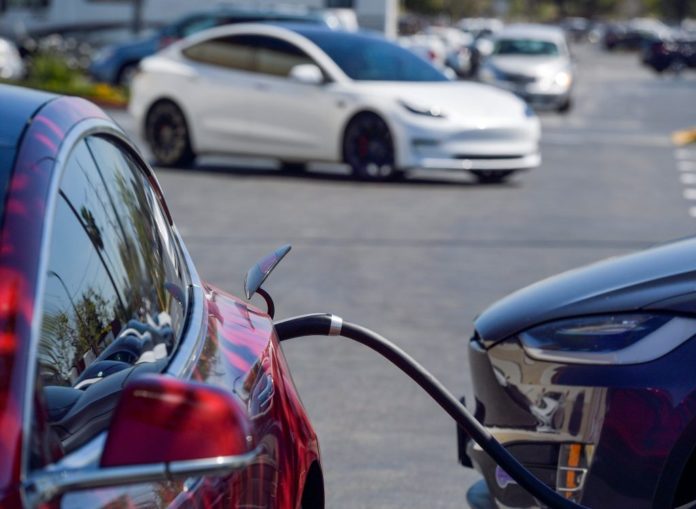It was cheeky, sure — but perfectly good journalism, and perfectly within the rules of the game.
Reporters and photographers from the CalMatters nonprofit news website, which focuses on California, simply walked the streets of the crazy-fancy Bay Area Peninsula city of Atherton, per capita the richest in America, and took pictures, and took notes.
That’s because the city of about 7,000 people has our state’s highest percentage of electric cars, in a town where “giant oaks and well-manicured hedges surround gated mansions owned by some of Silicon Valley’s most prominent billionaires, basketball stars, tech executives and venture capitalists.”
And indeed the photos used with the story, taken from the street and from drone vantage points, show all kinds of Teslas and Bolts and Rivian pickups on the very nice driveways of Atherton homes, where the minimum mandated lot size is a full acre. One gleaming white faux-Colonial manse, with a nice array of solar panels on the roof of its umpteen-bedroom spread, has what appears to be a worker’s internal-combustion truck in a circular drive out front, along with a conventional gasoline-powered family SUV — and two Tesla Model S cars in front of the garage.
It’s because our state’s residents — along with the world’s vehicle manufacturers — face a 2035 deadline, by which time 100% of the new cars sold here have to be zero-emission. And yet, CalMatters reports, “Communities with high concentrations of electric cars are affluent, college-educated and at least 75% white and Asian. In contrast, electric cars are almost nonexistent in Black, Latino, low-income and rural communities — revealing the enormous task that California faces electrifying the entire fleet.”
Electric cars are expensive — no problem if you’re an Apple executive. But how are the rest of us California motorists going to be able to afford to ditch our fossil-fueled cars?
It’s not just in a dozen years that we will be affected — the state mandate approved by the California Air Resources Board last year demands that 35% of cars sold in California, beginning with 2026 models, must be zero-emission, going up to 68% in 2030 and 100% in 2035.
The average cost of a new electric car in California is $58,385, which is about $9,600 more than the average gasoline-powered vehicle.
There is good news on that front, and it’s three-fold. First, that average is down from about $65,000 in 2022. Second, plain-wrap fully electric cars start around $27,500. Third, and quite unexpectedly, the price of lithium, required to create today’s electric car batteries, has dropped nearly 20% this year, allowing Tesla especially to cut the sticker prices for its vehicles.
Still, it’s the people who live in the Athertons, with 14% of their cars electric — and in Southern California, Santa Monica and Newport Coast — of our state who are buying today’s electric cars. Whereas, CalMatters reports, “In the 20 California ZIP codes where Latinos make up more than 95% of the population — including parts of Kings, Tulare, Fresno, Riverside and Imperial counties — between zero and 1% of cars are electric.”
Creating cleaner air and fighting climate change are admirable goals for California. But most non-upper-middle class people don’t have charging stations in their apartment parking lots. They face “range anxiety” once they do get on the road, where there are not enough public charging stations. Ensuring broad availability of charging stations will be a costly endeavor to the taxpayers of California.
California’s insistence on imposing zero-emission vehicle mandates reflects the fact that our one-party state government continues to reflect the wishes of upper-class elites unconcerned about the costliness or effectiveness of their visions.
California should pump the brakes on zero-emission vehicle mandates and let the market sort things out. If such vehicles are what the public needs and wants, such vehicles will become more affordable and available to broader sets of Californians. If what California wants to do is reduce greenhouse gas emissions, it should focus more on wildfire prevention.

